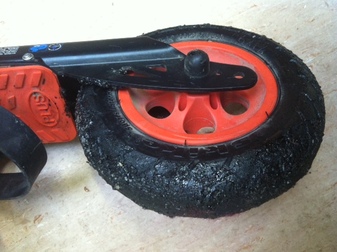
“I skiked from Marysville to Lake Mountain on Sunday afternoon and experienced a very soft road. There was a car rally in morning from the ticket office up to the top of the mountain and so the road had lots of liquid bitumen on its surface. I stopped at the timber yard about 2km from the top as my wheels had bitumen and stones stuck to them and rubbing against the frame.
I started cleaning my skikes last night and there are sharp stones embedded in 2 - 5 mm of bitumen and also stuck between the back wheels and the frame. I used a screw driver to chip away at the thick pieces and tonight I will be taking the wheels off to clean them properly and get to all sections of the frame. Turpentine was a good solvent to get the bitumen off my shoes and it didn't seem to damage the rubber.
I intend to use Turpentine to clean the wheels after I have already removed the thicker sections of bitumen. Unfortunately the bitumen has remained quite soft and sticky rather than hardening as I had expected.”
We think that turps, eucalyptus oil or a citrus based degreaser, liberal amounts of elbow grease and some old rags would probably be the way to do the job safely. Allowing the bitumen to go hard and using a screwdriver or a metal scraper may mark the powdercoat finish or score the wheels. Other commercially available products such as Tar & Bug Off may also work. Do not use things like acetone or WD-40 as they may work but will also attack rubber.
Other comments both helpful and humorous have also been received:
Kerosene would probably work, similar to turpentine. Its a thinner for the bitumen sprayed onto the road for sealing. It slowly evaporates and the bitumen hardens up, but on hot days the bitumen gets very tacky if there has not been much time for the kero to evaporate, as seems was the case.
Of course, you can just "wear" the bitumen off the tyres. It might be a bit slow and bumpy at first... :-)
Have you ever needed to clean bitumen, an incrustation of filth, or any other crud from your skikes? If so, what did you use? Add a comment to this blog and help another fellow skiker.

